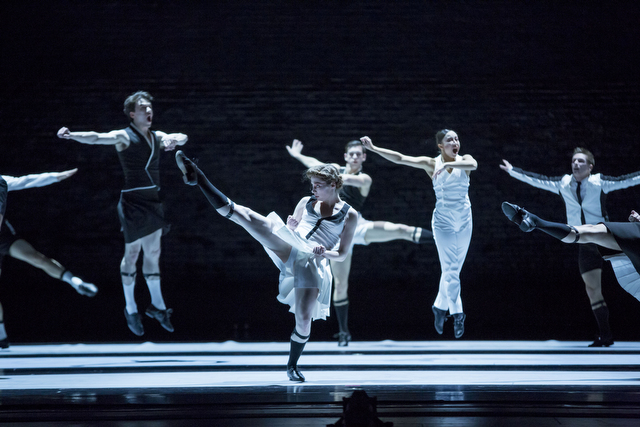Review: The Joffrey Ballet at the Granada Theatre
America’s Premier Company Dazzled on Tuesday, March 10

Since its founding in 1956, the Joffrey Ballet has been centered in Los Angeles and New York. Having been on both ends of the U.S. and now in its middle (the company currently calls Chicago home), the Joffrey reflects America’s diversity in more than its geographic wanderings. Company members come from all over the world. In accordance with the theme of diversity, Tuesday’s program at the Granada included three strikingly different works.
The first piece, “Incantations,” was an elegant visualization of a score created by Alexandre Rabinovitch-Barakovsky, a piece the composer describes in the Joffrey’s program notes as a “very intense panting prayer, spread out over one very long breath.” Sandra Woodall’s buff-colored costumes featured burgundy spirals and swirls. Spiraling, swooping, hypnotic movements were punctuated by moments powerful enough to cause audible gasps from the audience: a soloist executing a series of ridiculously fast piqué turns, the men diving into surprising combinations of balletic jumps with contemporary details, moments where women were spun around men in flat-footed turns that recalled ice dancing.
The second work, “Son of Chamber Symphony,” was choreographed by Stanton Welch to music by John Adams. Welch described his initial experience of Adams’s music as similar to “looking at the inner workings of a clock” — all the cogs and springs and wheels of a classical music piece are there, in entirely a different kind of organization than one would expect. The piece played with classical balletic vocabulary and costuming, shuffling those ingredients around to create surprising juxtapositions of the expected and the new.
“Episode 31” by Swedish choreographer Alexander Ekman followed the second intermission. A short film gave the audience a glimpse into the rehearsal process. After the formality of the first two pieces, we got to see the dancers up close and personal. First, they worked in the studio; next, they took bits of the piece outdoors, performing them flash-mob style around the city. Only after these stages of evolution did they bring the piece to the stage.
Zack Winokur’s complex staging included multiple lifts and lowerings of the curtain, lamps carried to and fro, all wings and rear curtains pulled back to reveal the bones of the stage, lighting elements dropped in and out from the fly space and carried across the stage, and flooring that was lifted, jumbled, and rotated. Unisex costuming played with themes of trousers, skirts, vests, garters, ties, proper button-down shirts, socks, and shoes, all in black-and-white.
The movement and use of vocalization and gesture reflected Ekman’s trademark sense of humor and impeccable timing. The whole business was framed by a man in a suit and tie, who opened the piece by turning on a lamp at far downstage left in front of the closed curtains and who spent the entire piece walking a slow-motion circuit around the action. Chaos fell to order and back to chaos — the kind of chaos that mirrors nature, where you know there’s an order and you haven’t quite wrapped your brain around it yet. The incredible precision of the dancers shone through strongest in this more contemporary work. A few moments of lyrical, balletic beauty bubbled up but not without a nudge and a wink. In the background, a dancer slowly strode across the upstage with a big sign reading “(beautiful).”



